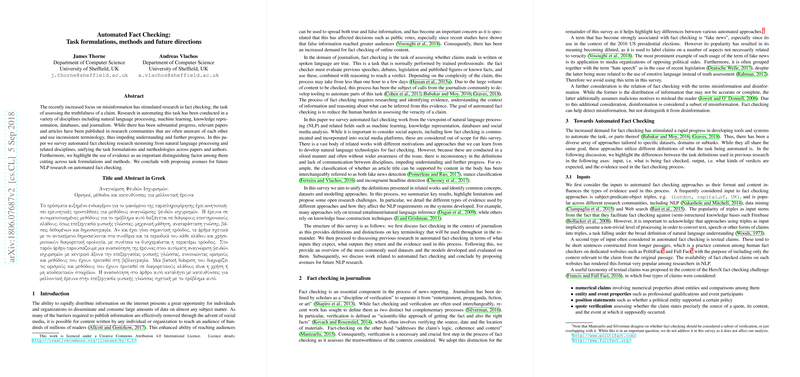Automated Fact Checking: Task Formulations, Methods, and Future Directions
The paper "Automated Fact Checking: Task Formulations, Methods, and Future Directions" by James Thorne and Andreas Vlachos provides a comprehensive survey of research efforts in automating the fact-checking process, drawing primarily from NLP and related fields. As misinformation becomes increasingly prevalent due to the rapid dissemination of information via the internet and social media, automated fact-checking systems have garnered interest across various disciplines, including machine learning, knowledge representation, and journalism.
Overview of Automated Fact Checking
Automated fact-checking involves evaluating the truthfulness of a claim, a task traditionally performed by trained journalism professionals. Given the volume of information circulating online, and the fact that false information often reaches larger audiences, there is a pressing need for automation to reduce the human workload involved in fact verification. The paper reviews existing work in this domain, exploring definitions, task inputs, evidence sources, and expected outputs in automated fact-checking systems.
Task Formulations
The paper categorizes task formulations for automated fact-checking across different dimensions:
- Inputs: Claims can be represented as structured triples (subject-predicate-object), textual sentences, or entire documents. Each format demands varying levels of processing complexity, with sentence and document-level inputs often requiring sophisticated NLP techniques for parsing and claim extraction.
- Evidence Sources: Automated systems rely on different sources of evidence, from knowledge graphs and previously fact-checked claims to textual data (e.g., Wikipedia) and social media behavior. The trustworthiness of these sources is critical yet often overlooked.
- Outputs: The outputs of automated fact-checking range from binary true/false classifications to more nuanced scales of veracity. Some systems provide supporting evidence alongside the veracity verdict, while others focus solely on generating a truth label.
Methodologies
The paper reviews various methodologies employed in automated fact-checking, most notably supervised learning approaches. These models, trained on labeled datasets, tackle tasks such as text classification and natural language inference (NLI), deriving veracity based on linguistic features and external evidence. Nonetheless, the authors highlight the limitations of these models in scenarios demanding deep reasoning or dealing with claims involving unobserved events.
Implications and Future Directions
The survey underscores the importance of addressing several challenges in automated fact-checking, including:
- Open-World Knowledge Integration: Current systems predominantly operate under closed-world assumptions, relying on pre-existing data and evidence. Future systems should incorporate open-world knowledge, enabling them to retrieve and verify facts dynamically.
- Data Scarcity: The lack of large-scale, diverse datasets limits the development and refinement of fact-checking algorithms. Enhanced datasets encompassing complex and compound information could facilitate more advanced machine learning models.
- Multimodal Fact-Checking: Future research should explore the integration of non-textual evidence (e.g., images, videos) into fact-checking frameworks, leveraging advancements in multimodal processing technologies.
- Rationale Generation: While systems currently provide fact-checking labels, generating human-like rationales or justifications for these labels is an emerging area of interest, demanding further exploration.
This paper serves as a valuable resource for researchers in the field of automated fact checking, presenting a unified perspective on existing methodologies and charting a path for future inquiry. While it emphasizes the strides made in automating fact verification, it also acknowledges the significant challenges that remain, particularly in simulating the complex reasoning capabilities of human fact-checkers. The continuous development of automated systems that can efficiently and accurately assess the veracity of information is crucial in the ongoing effort to mitigate the impact of misinformation.
